|
According to online
sources, the OE-2 (aka the Bird Dog II) is a redesigned version of the OE-1 with Cessna
180 wings and fuselage modified for better visual observation. This R/C model by Bob
Wischer has a 54" wingspan and is powered by a .09 to .15 engine. The original, having
been built in the early 1960s, used an escapement for rudder-only control. A modern micro
or mini R/C system would easily permit 3- or 4-channel operation with probably about
the same all-up flying weight. You could even convert it to electric power as is the
popular thing to do these days.
See the 4-view drawing of the Cessna
OE-2 from the February 1957 edition of American Modeler, inked by Walter
M. Jefferies, Jr.
Winning R/C Scale: Cessna OE-2 Marine Observation Plane

At Wisconsin's Waukesha County Airport
model Cessnas turned out by the Wischer clan look like the big USMC product. OE-2
on left flew in Nats, one at right is drawn.
Full size plans are by Hobby Helpers.
|
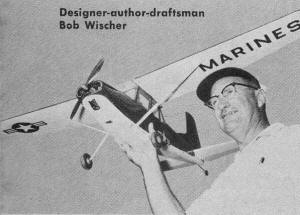
Designer-author-draftsman Bob Wischer
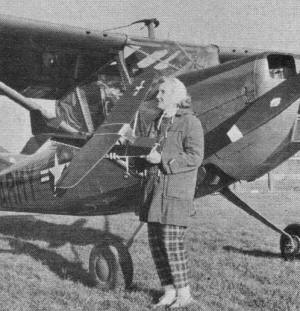
Mrs. Bob (Dolly) Wischer and Army's TL-19D Cessna.

Receiver in foam; OS throttle escapement; Bonner Varicomp (rear).
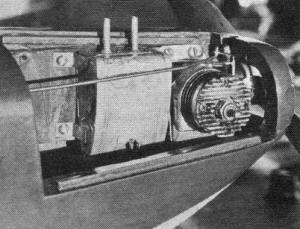
Fox with clapper throttle; tank; modified so all tubes are on same side, is fastened
by brass angles.
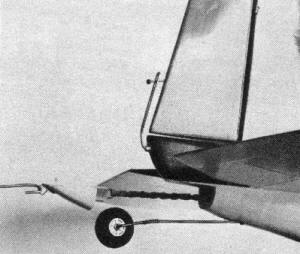
Wischer's OE-2 Cessna: Removable tail plug for winding escapement rubber; 1/16" music
wire torque rod end.
|
Ever watch the crowd gather when an R/C scale job is about to be flown? There's something
powerfully attractive about the sight of a model of a real plane skimming lightly down
the runway, taking off and returning overhead looking every bit like the full size aircraft.
This kind of satisfaction is the scale modeler's reward for the time and effort spent
in careful building, finishing and trimming. But his painstaking struggle is wasted if
he chooses a plane of such design that it can be flown only by an expert.
Any of the single-engine Cessnas will fly well as a model; the Cessna A was a favorite
for rubber power 30 years ago, and today's descendants will perform as well in R/C. They
have all the natural stability of a well proportioned high-wing cabin monoplane, requiring
only a minimum of modification to produce a plane capable of flying with the best of
the specialized R/C types.
Our Cessna has had its 'stabilizer span increased by 2 inches for greater stability,
and the wing airfoil changed from NACA 2412 to 2415 to permit slower flight and help
carry the R/C load. The down thrust shown on the plan is identical with that of the real
plane; only side thrust had to be added. Dihedral was increased only slightly. The force
set-up evolved agrees closely with that of a high performance R/C airplane. To be certain
of a good flying plane, the builder needs only to keep the weight down to a reasonable
figure by careful selection of balsa, especially behind the wing. Like most scale models
it is almost impossible to build one nose heavy, therefore use the lightest balsa available
in the tail section and the heavy block construction in the nose.
The question of whether to apply a super-finish is the scale builder's dilemma. Of
the two OE-2 planes built by the writer, one has a fancy finish with 14 coats built up
into a thick layer of smooth glossy dope. The other has a less velvety finish of 8 coats
but is 12 ounces lighter and consequently flies much better. Possibly a compromise would
be the answer since the lighter plane has a wing loading of only 19 ounces per square
foot. One consideration that could influence the builder's decision is the ease of patching
a thin finish; and the often-flown lightweight plane is more vulnerable to damage because
it makes more landings. A common sight at contests is the beautifully finished model
which the owner is reluctant to fly because he does not wish to damage the product of
many hours of labor and representing quite an outlay in cash. These models often weigh
so much that a high speed is required to get them airborne and the end result is a mighty
splat when they make contact with the unyielding earth. For more fun flying and less
work patching, keep the weight down.
Contest judges are not always in agreement on the matter of finish. Some will insist
that a military plane like the OE-2 should have a dull finish same as the prototype and
will penalize the builder who shows up with a gloss. Others are completely taken in by
the glitter and will give the prize to a plane so heavy with finish that it will barely
fly.
If the builder plans to enter his OE-2 in contests he will be obliged to furnish proof
of authenticity. By far the best source in this case is his file of American Modelers
where he will find the well executed scale presentation by Walter Jefferies in the February
1957 issue. This drawing was repeated in the 1957/1958 issue of Air Progress. A larger
but less detailed drawing was obtained from Cessna Aircraft Company of Wichita, Kansas.
For photos of the real plane see the Winter 1960 edition of Air Progress or write to
Aviation Photo Exchange, Box 75084, Los Angeles 5, California. The writer's OE-2 has
been entered in a number of contests and has collected its share of prizes, including
two first places.
Flying the OE-2 requires no special skill or experience as it is a very forgiving
airplane if properly balanced. Since the batteries and receiver cannot be moved very
far fore and aft, they are not much help as ballast. Very likely the model will be slightly
tail heavy when balanced at the point shown on the plan, and some compensation will have
to be made in the form of weights added in the nose. When the plane is viewed head-on
a deep pocket will be seen just to the right of the engine crankcase and this is a handy
place to add weights. About 2 ounces of solder is used in the writer's plane and this
is held in place by surrounding it with modeling clay. Weight should be added to obtain
a flat glide ending in a 2 wheel landing, not a 3 point landing. If the nose comes up
in the glide or if the tail wheel touches in landing, add more weight to the nose.
With a .15 engine the OE-2 may be slightly overpowered, and first flights should be
with a rich mixture to help slow it down. Rudder movement of 3/8" to 1/2" will produce
turns that are not too steep. Due to the low dihedral in the wing there is a tendency
for the OE-2 to continue turning after rudder is neutralized but this was considered
acceptable in view of the improvement in scale appearance. Simply blip opposite rudder
to stop the turn. Actually this type of flying results in smooth turns since there is
no jerking as there would be in blipping around a turn. The receiver used is a Kraft
operating a compound escapement and a two position throttle escapement. A clapper valve
is employed over the venturi of the Fox .15 to give two speed control. A new engine may
overheat if run with the removable cowl in place. Most flying is done with the cowl and
wing struts removed ... however, in a contest they must remain in place or the flier
risks disqualification.
Troublesome ground-looping tendencies are the main reason that some R/C models will
not make those desirable, long, straight take-off runs. This could be caused by misalignment
of the wheels or binding between wheel and axle, but is more' likely to result from the
wheels being located too far forward relative to the plane's center of gravity. Should
this occur with the OE-2, a small balsa block can be placed between the floor and the
forward extension of the front landing gear leg to force the wheels toward the rear.
Do not carry this too far as a nose-over could result, and also scale appearance will
suffer.
Construction data appears on the full size Hobby Helpers' plans (Group #762).

Cessna OE-1 Plans (sheet 1)
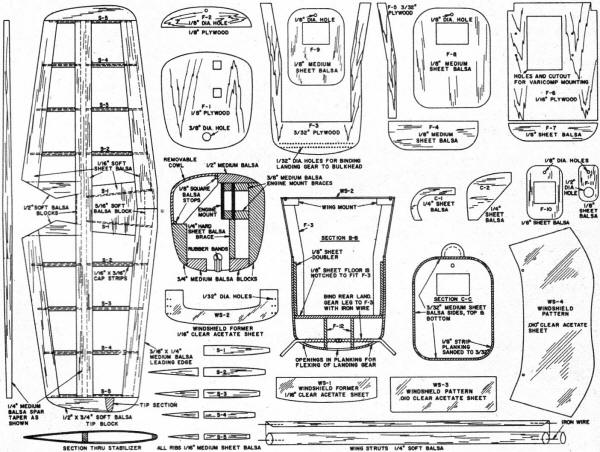
Cessna OE-1 Plans (sheet 2)
Notice:
The AMA Plans Service offers a
full-size version of many of the plans show here at a very reasonable cost. They
will scale the plans any size for you. It is always best to buy printed plans because
my scanner versions often have distortions that can cause parts to fit poorly. Purchasing
plans also help to support the operation of the
Academy of Model Aeronautics - the #1
advocate for model aviation throughout the world. If the AMA no longer has this
plan on file, I will be glad to send you my higher resolution version.
Try my Scale Calculator for
Model Airplane Plans.
Posted July 5, 2014
|